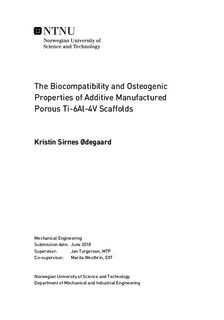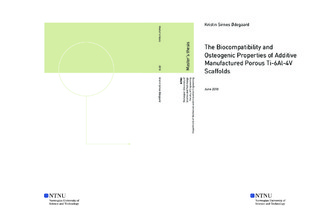| dc.description.abstract | Human bone is constantly being remodeled, and has the ability to repair itself when damage occurs. However, sometimes the fractures are so intense that they exceed the critical non-healable size. In order to repair such fractures, external fixation, such as implants, may be required.
Titanium and its alloys have, for a long time, been used as solid implants to repair bone damages. These alloys have the ability to form an interlocking bond with human bone. However, due to the big difference in stiffness between the solid titanium implant and human bone, resorption of bone might occur, which eventually might lead to implant failure.
By implementing additive manufacturing, one can produce porous metal implants, with an elastic modulus designed to mimic the stiffness of human bone. This can eliminate the risk of bone resorption and pave the way towards a long lasting prosthetic implant. However, it is still uncertain how much additive manufacturing and porous structures might affect the biocompatibility and osteogenic properties of the implant.
This thesis describes the \textit{in vitro} investigation of the biocompatibility and osteogenic properties of additive manufactured porous scaffolds. The scaffolds were designed with a pore- and lattice diameter of 800µm, and a porosity of 60%. The scaffolds were manufactured using electron beam melting (EBM) by employing the alloy Ti-6Al-4V. In order to find the biocompatibility, the scaffolds were seeded with bone marrow-derived mesenchymal stromal cells (BMSC). Immediately after being seeded, the cells adhered to the surface of the scaffolds, and subsequently proliferated. This infers that EBM manufactured scaffolds are biocompatible.
The osteogenic potential of BMSC cultured on the scaffolds was studied using ALP- and ARS-staining and gene expression analysis. Results from ALP and ARS analysis inferred that the BMSC became mature, functional osteoblasts, when cultured in osteogenic medium. | |

